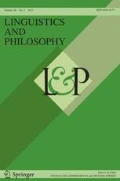Abstract
The paper shows how ideas that explain the sense of an expression as a method or algorithm for finding its reference, preshadowed in Frege’s dictum that sense is the way in which a referent is given, can be formalized on the basis of the ideas in Thomason (1980). To this end, the function that sends propositions to truth values or sets of possible worlds in Thomason (1980) must be replaced by a relation and the meaning postulates governing the behaviour of this relation must be given in the form of a logic program. The resulting system does not only throw light on the properties of sense and their relation to computation, but also shows circular behaviour if some ingredients of the Liar Paradox are added. The connection is natural, as algorithms can be inherently circular and the Liar is explained as expressing one of those. Many ideas in the present paper are closely related to those in Moschovakis (1994), but receive a considerably lighter formalization.
Similar content being viewed by others
References
P. Andrews (1971) ArticleTitle‘Resolution in Type Theory’. Journal of Symbolic Logic 36 IssueID3 414–432
K. Apt (1990) ‘Introduction to Logic Programming’ J. Leeuwen Particlevan (Eds) Handbook of Theoretical Computer Science Vol. B. Elsevier Amsterdam 495–574
J. Barwise (1997) ArticleTitle‘Information and Impossibilities’. Notre Dame Journal of Formal Logic 38 IssueID4 488–515 Occurrence Handle10.1305/ndjfl/1039540766
J. Barwise J. Etchemendy (1987) The Liar: An Essay on Truth and Circularity Oxford University Press New York
Benzmüller C., Brown C.E., Kohlhase M. (2004) ‘Higher Order Semantics and Extensionality’. Journal of Symbolic Logic 69, (to appear).
Blackburn P., Bos J., Striegnitz K. (2001) Learn Prolog Now! www.consem.org.
R. Carnap (1947) Meaning and Necessity Chicago UP Chicago
G. Chierchia R. Turner (1988) ArticleTitle‘Semantics and Property Theory’ Linguistics and Philosophy 11 261–302 Occurrence Handle10.1007/BF00632905
A. Church (1940) ArticleTitle‘A Formulation of the Simple Theory of Types’ Journal of Symbolic Logic 5 56–68
M. Cresswell (1972) ArticleTitle‘Intensional Logics and Logical Truth’ Journal of Philosophical Logic 1 2–15 Occurrence Handle10.1007/BF00649986
M. Cresswell (1985) Structured Meanings MIT Press Cambridge, MA
G. Dowek (2001) ‘Higher-Order Unification and Matching’ A. Robinson A. Voronkov (Eds) Handbook of Automated Reasoning. Elsevier Amsterdam 1009–1062
M. Dummett (1978) Truth and Other Enigmas Duckworth London
M. Fitting (2002) Types, Tableaus, and Gödels God Kluwer Academic Publishers Dordrecht
C. Fox S. Lappin (2001) ‘A Framework for the Hyperintensional Semantics of Natural Language with Two Implementations’ P. De Groote G. Morrill C. Retoré (Eds) Logical Aspects of Computational Linguistics. Springer-Verlag Berlin 175–192
Fox, C., Lappin S., and C. Pollard: (2002), ‘A Higher-order Fine-grained Logic for Intensional Semantics’, in Alberti G., Balough K., and P. Dekker (eds.), Proceedings of the Seventh Symposium for Logic and Language, pp. 37–46, Pecs, Hungary.
W. Goldfarb (1981) ArticleTitle‘The Undecidability of the Second-order Unification Problem’ Theoretical Computer Science 13 225–230 Occurrence Handle10.1016/0304-3975(81)90040-2
J. Hintikka (1975) ArticleTitle‘Impossible Possible Worlds Vindicated’ Journal of Philosophical Logic 4 475–484 Occurrence Handle10.1007/BF00558761
G. Huet (1973) ArticleTitle‘The Undecidability of Unification in Third-Order Logic’ Information and Control 22 257–267 Occurrence Handle10.1016/S0019-9958(73)90301-X
S. Kripke (1975) ArticleTitle‘Outline of a Theory of Truth’ Journal of Philosophy 72 690–716
Lappin, S. and C. Pollard: (2000), ‘Strategies for Hyperintensional Semantics’. ms.
D. Lewis (1972) ‘General Semantics’ D. Davidson G. Harman (Eds) Semantics of Natural Language. Reidel Dordrecht 169–218
D. Miller (1991) ArticleTitle‘A Logic Programming Language with Lambda-abstraction, Function Variables, and Simple Unification’. Journal of Logic and Computation 1 497–536
Montague, R.: (1970), ‘Universal Grammar’, in Formal Philosophy, pp. 222–246, Yale University Press, New Haven.
Montague R.: (1973), ‘The Proper Treatment of Quantification in Ordinary English’, in Formal Philosophy, pp. 247–270, Yale University Press, New Haven.
Moschovakis, Y.: (1994), ‘Sense and Denotation as Algorithm and Value’, in Logic Colloquium ’90 (Helsinki 1990), Vol. 2 of Lecture Notes in Logic, pp. 210–249, Springer, Berlin.
Moschovakis, Y.: (2003), ‘A Logical Calculus of Meaning and Synonymy’, Corrected and edited notes for a course in NASSLLI 2003.
R. Muskens (1991) ArticleTitle‘Hyperfine-Grained Meanings in Classical Logic’ Logique et Analyse 133/134 159–176
R. Muskens (2005) ‘Higher Order Modal Logic’ P. Blackburn J. Benthem Particlevan F. Wolter (Eds) Handbook of Modal Logic, Studies in Logic and Practical Reasoning. Elsevier Dordrecht
D. Prawitz (1968) ArticleTitle‘Hauptsatz for Higher Order Logic’ Journal of Symbolic Logic 33 IssueID3 452–457
V. Rantala (1982) ArticleTitle‘Quantified Modal Logic: Non-normal Worlds and Propositional Attitudes’ Studia Logica 41 41–65 Occurrence Handle10.1007/BF00373492
M. Takahashi (1967) ArticleTitle‘A Proof of Cut-elimination Theorem in Simple Type Theory’ Journal of the Mathematical Society of Japan 19 IssueID4 399–410
R. Thomason (1980) ArticleTitle‘A Model Theory for Propositional Attitudes’ Linguistics and Philosophy 4 47–70 Occurrence Handle10.1007/BF00351813
P. Tichý (1988) The Foundations of Frege’s Logic De Gruyter Berlin
R. Turner (1987) ArticleTitle‘A Theory of Properties’ Journal of Symbolic Logic 52 IssueID2 455–472
van Lambalgen, M. and F. Hamm: (2003), ‘Moschovakis’ Notion of Meaning as Applied to Linguistics’, in M. Baaz and J. Krajicek (eds.), Logic Colloquium ’01, ASL Lecture Notes in Logic.
E. Zalta (1997) ArticleTitle‘A Classically-Based Theory of Impossible Worlds’ Notre Dame Journal of Formal Logic 38 IssueID4 640–660 Occurrence Handle10.1305/ndjfl/1039540774
Author information
Authors and Affiliations
Corresponding author
Additional information
This paper is based on talks held at the Sinn und Bedeutungworkshop in Osnabrück 2001 and the Sinn und Bedeutungworkshop in Konstanz 2002. I would like to thank my audiences there for asking the right questions. Two anonymous referees gave valuable comments.
Rights and permissions
About this article
Cite this article
Muskens, R. Sense and the Computation of Reference. Linguist Philos 28, 473–504 (2005). https://doi.org/10.1007/s10988-004-7684-1
Issue Date:
DOI: https://doi.org/10.1007/s10988-004-7684-1




